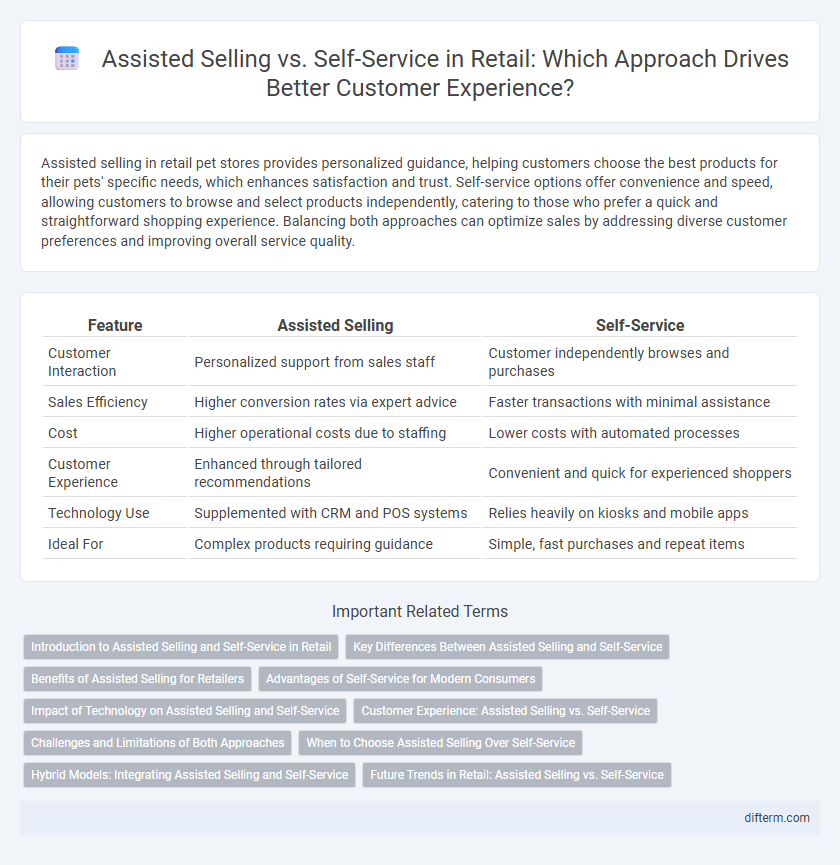Assisted selling in retail pet stores provides personalized guidance, helping customers choose the best products for their pets' specific needs, which enhances satisfaction and trust. Self-service options offer convenience and speed, allowing customers to browse and select products independently, catering to those who prefer a quick and straightforward shopping experience. Balancing both approaches can optimize sales by addressing diverse customer preferences and improving overall service quality.
Table of Comparison
| Feature | Assisted Selling | Self-Service |
|---|---|---|
| Customer Interaction | Personalized support from sales staff | Customer independently browses and purchases |
| Sales Efficiency | Higher conversion rates via expert advice | Faster transactions with minimal assistance |
| Cost | Higher operational costs due to staffing | Lower costs with automated processes |
| Customer Experience | Enhanced through tailored recommendations | Convenient and quick for experienced shoppers |
| Technology Use | Supplemented with CRM and POS systems | Relies heavily on kiosks and mobile apps |
| Ideal For | Complex products requiring guidance | Simple, fast purchases and repeat items |
Introduction to Assisted Selling and Self-Service in Retail
Assisted selling in retail involves personalized customer interaction with sales associates providing expert advice, product recommendations, and tailored solutions to enhance the shopping experience. Self-service empowers customers to independently explore products, compare features, and complete purchases using digital kiosks, mobile apps, or online platforms. Both methods optimize sales strategies by balancing human expertise and technology-driven convenience to meet diverse consumer preferences.
Key Differences Between Assisted Selling and Self-Service
Assisted selling involves direct interaction with sales associates who provide personalized recommendations and product knowledge, enhancing customer experience and increasing conversion rates. Self-service allows customers to independently browse products, access digital information, and complete purchases, offering convenience and speed. Key differences include the level of human interaction, customer engagement depth, and the reliance on technology for product discovery and transaction completion.
Benefits of Assisted Selling for Retailers
Assisted selling enhances customer satisfaction by providing personalized recommendations and expert advice, leading to increased conversion rates and higher average transaction values. Retailers benefit from improved inventory management as sales associates can promote high-margin products and upsell effectively. Enhanced customer loyalty results from tailored interactions, driving repeat business and long-term revenue growth.
Advantages of Self-Service for Modern Consumers
Self-service in retail significantly enhances convenience by allowing consumers to browse and purchase products at their own pace without waiting for assistance. It caters to modern preferences for instant access and control, reducing transaction times and improving overall shopping satisfaction. Integration with digital tools like kiosks and mobile apps further empowers customers, streamlining decision-making and personalizing the shopping experience.
Impact of Technology on Assisted Selling and Self-Service
Advanced AI-driven tools and interactive kiosks enhance assisted selling by providing personalized recommendations and real-time inventory updates, elevating customer satisfaction and increasing sales conversion rates. Self-service technologies, such as mobile apps and touchscreens, empower shoppers with quick product information access, reducing wait times and operational costs. Integration of IoT devices and data analytics optimizes both sales methods by tailoring experiences to consumer behavior and streamlining store operations.
Customer Experience: Assisted Selling vs. Self-Service
Assisted selling enhances customer experience by providing personalized guidance and expert recommendations, leading to increased satisfaction and higher conversion rates. Self-service options empower customers with convenience and speed, catering to those who prefer autonomy and quick transactions. Combining both approaches optimizes the retail environment, accommodating diverse shopper preferences and boosting overall engagement.
Challenges and Limitations of Both Approaches
Assisted selling faces challenges such as high labor costs, inconsistent customer service quality, and potential pressure on customers, which can deter purchases. Self-service kiosks and digital platforms limit personalized interaction, often leading to customer frustration with technology or confusion during complex purchases. Both approaches struggle with balancing efficiency and customer satisfaction, requiring retailers to adapt solutions based on shopper preferences and store environments.
When to Choose Assisted Selling Over Self-Service
Assisted selling is ideal for high-value or complex products requiring expert advice and personalized recommendations, enhancing customer confidence and satisfaction. Retail environments with diverse product ranges and customers seeking tailored solutions benefit from knowledgeable staff guiding purchases. Choosing assisted selling over self-service maximizes conversion rates and reduces returns when product understanding or customization is critical.
Hybrid Models: Integrating Assisted Selling and Self-Service
Hybrid retail models combine assisted selling with self-service technologies to enhance customer experience and increase sales efficiency. Interactive kiosks, mobile apps, and knowledgeable staff work synergistically, allowing shoppers to choose their preferred shopping method while receiving personalized support when needed. Such integration drives higher engagement, reduces wait times, and improves overall satisfaction in omnichannel retail environments.
Future Trends in Retail: Assisted Selling vs. Self-Service
Future retail trends emphasize a hybrid model combining assisted selling and self-service technologies, enhancing customer experience through personalized interactions and efficiency. Advanced AI-driven chatbots and augmented reality tools support sales associates in providing tailored recommendations while self-checkout kiosks and mobile apps streamline transactions. Retailers leveraging data analytics to balance human expertise with automated convenience are poised to drive higher satisfaction and loyalty in evolving consumer landscapes.
assisted selling vs self-service Infographic

 difterm.com
difterm.com